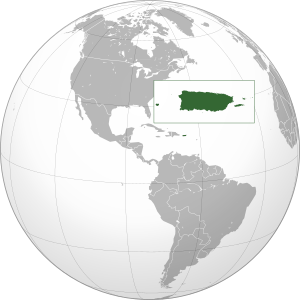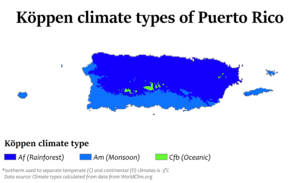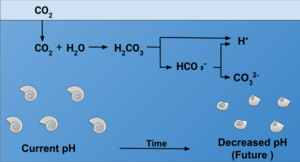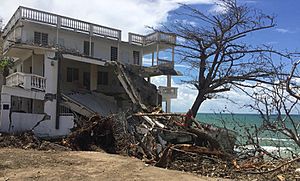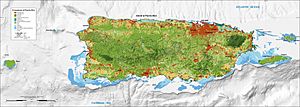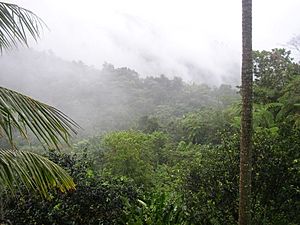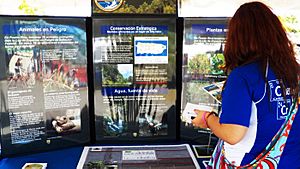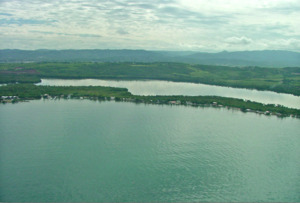Climate change in Puerto Rico facts for kids
Puerto Rico is a beautiful island in the Caribbean Sea. But it's facing big challenges from climate change. The US Environmental Protection Agency says Puerto Rico is one of the places most affected by climate change in the world.
Puerto Rico gets most of its energy from fossil fuels that are brought in from other places.
Even though it's a small island, Puerto Rico has many different ecosystems. These include coasts, forests, and mountains. Climate change affects each of these in different ways.
The Puerto Rico Climate Change Council (PRCCC) has pointed out seven key climate changes happening there. These are changes in air temperature, precipitation (rain), extreme weather events, tropical storms and hurricanes, ocean acidification, sea surface temperature, and sea level rise.
Climate change doesn't just affect nature. It also impacts the people of Puerto Rico. This includes their jobs, health, and sometimes even forces them to move.
People in Puerto Rico are becoming more aware of climate change. Their laws and plans are now focusing on how to slow down climate change (called climate change mitigation) and how to live with its effects (called adaptation). For example, they want to use more renewable energy. Many local groups and international aid programs are also helping. They support rebuilding after storms and planning for future disasters.
Contents
What are Greenhouse Gas Emissions?
Greenhouse gases are gases in the Earth's atmosphere that trap heat. They are a main cause of climate change. Puerto Rico is the 19th biggest producer of carbon dioxide (CO₂) among 33 countries in Latin America and the Caribbean. The main sources of these gases on the island are factories, energy use, and transportation.
Between 1990 and 2005, Puerto Rico's CO₂ emissions went up by 80%. After 2005, they dropped by about 42% until 2018. However, some of this drop was because fewer people lived on the island. From 2010 to 2020, Puerto Rico's population went down by almost 12%. Many people moved to the U.S. because of natural disasters and money problems.
How Puerto Rico Uses Energy
Puerto Rico uses almost 70 times more energy than it makes. Compared to the U.S. average, each person in Puerto Rico uses about one-third as much energy.
Most of the energy used (58%) comes from petroleum products. Natural gas makes up the second largest part at 28%. Coal is 12% of Puerto Rico's energy. Only about 2% comes from renewable sources like solar or wind power.
Puerto Rico wants to use more renewable energy. They have laws like Act No. 82-2010 to help with this. Groups like Casa Pueblo are also working towards this goal.
| Puerto Rico | United States | |
|---|---|---|
| Total Fossil Fuels | 5.52 | 14.78 |
| Petroleum | 3.37 | 6.76 |
| Natural Gas | 1.23 | 4.99 |
| Coal | 0.92 | 3.02 |
| Source: Based on data from the U.S. Energy Information Administration | ||
Where Fossil Fuels Come From
Puerto Rico does not have its own fossil fuels. All the fossil fuels it uses for energy are brought in from other countries.
How Climate Change Affects Nature
To understand climate change, we need to know about "natural variability." This is the normal yearly changes in weather, like temperature and rain. Things like El Niño or volcanic eruptions cause these natural changes.
But human activities, like releasing greenhouse gases (such as CO₂ and methane) and changing land, also affect the climate. Scientists look for "climate change signals" to see how human actions are changing the climate beyond natural ups and downs.
Changes in Weather Patterns
Puerto Rico has a tropical climate. This means it's warm and humid all year. The US Environmental Protection Agency says it's one of the most affected places by climate change. The Puerto Rico Climate Change Council (PRCCC) has listed seven key changes. These include air temperature, rain, extreme weather, storms, ocean acidity, sea temperature, and sea level.
Air Temperature
The average yearly temperature in Puerto Rico has gone up. It was about 23°C in 1921 and reached 25°C in 2021. This warming trend is stronger in Puerto Rico than in other Caribbean islands.
Higher areas in central Puerto Rico are warming faster. Also, cities like San Juan are becoming "urban heat islands." This means they get hotter than nearby rural areas. Studies in San Juan show that the city can be more than 4°C hotter than the countryside. This trend is expected to continue. San Juan could reach an average of 27°C by 2050.
Extreme Weather
Puerto Rico is seeing more very hot days. In the early 1900s, there were about 100 days per decade that reached over 32.2°C. But by 2010, that many hot days happened in just one year!
Rain Patterns
As a tropical island, Puerto Rico naturally gets a lot of rain. Especially in the north and central areas, which can get 3-4 meters of rain each year. Rain amounts vary across the island because of its mountains and location. Climate change is making these differences even bigger.
For example, some areas like Old San Juan are getting less rain over time. This trend is expected to continue. But southern Puerto Rico, which used to be drier, is now getting more rain. The seasons are also changing. Winters are expected to be wetter, and summers drier. Overall, less rain is expected in the future.
However, when it does rain, it's often much heavier. Heavy rainfall has increased by 20% in North America on average. Puerto Rico has seen a 37% increase in heavy rain. This means rain will be less frequent but more intense.
Water Resources
Changes in rain patterns can affect water supplies. Areas that rely on rain for water might see more extreme rain, bigger seasonal changes in water flow, and more long dry spells. This means a higher risk of both droughts and floods.
Long dry periods can make lake levels drop. Lakes are a key source of fresh water. When surface water decreases, people will need to use more groundwater. This is especially true in dry months. Long dry periods can also dry out the soil. This means farmers will need more irrigation for their crops.
Sea Surface Temperature
Over the last 100 years, the surface temperature of the Caribbean Sea has warmed by 1.5°C. The warming is faster on Puerto Rico's Caribbean coasts than on its Atlantic coasts. Also, temperatures deeper in the ocean are rising faster than surface temperatures.
In 2018, scientists thought sea temperatures could rise by more than 1°C within 50 years. This would mean temperatures would be too high for coral bleaching for about one-third of the year. It would also mean temperatures would be high enough for strong storms to form all year.
Sea Level Rise
The sea level around Puerto Rico has been rising. From 1900, it rose about 1.7 millimeters each year. But recent satellite data from 1992 shows it has almost doubled to 3.2 millimeters a year.
Future predictions for sea level rise in Puerto Rico are similar to global estimates. The National Oceanographic and Atmospheric Administration (NOAA) suggests the sea could rise between 0.3 meters and 2.5 meters by the end of the century. The Caribbean, including Puerto Rico, is very likely to experience coastal flooding because of this.
Ocean Acidification
When more carbon dioxide (CO₂) goes into the atmosphere, the ocean absorbs more of it. This makes the ocean water more acidic. This process is called ocean acidification. It harms marine life and geological processes. It makes it harder for sea creatures to build their shells and skeletons.
Puerto Rico is seeing similar trends to the rest of the world. The ocean around it is becoming more acidic. The rate at which aragonite (a mineral important for shells) is dissolving is currently 3% per decade. This is expected to continue if emissions don't stop.
Tropical Storms and Hurricanes
Since 1995, the North Atlantic has seen more hurricane activity. While natural changes play a role, climate change is also a factor. It's hard to predict future hurricane activity exactly. However, many studies suggest that hurricanes worldwide will become less frequent but more intense. This means they will have stronger winds and heavier rain, causing more damage.
In Puerto Rico, Hurricanes Irma and Maria in 2017 showed these predicted impacts. They caused huge damage in the Caribbean. One result was damage to the island's coral reefs. These reefs usually help protect the coasts from waves. Without them, there's a higher risk of damage from winter waves, leading to coastal erosion. The southern part of the island is especially at risk from Atlantic hurricanes. In the future, warmer sea surface temperatures will likely lead to more intense rain, winds, and storm surges.
Ecosystems
Even though Puerto Rico is small, it has many different ecosystems. These include coastal and marine areas, dry forests, rainforests, unique karst landscapes, and mountains.
Climate change is expected to have "synergistic effects" on these ecosystems. This means that systems already under stress will face even more challenges. This could lead to losing habitat, changes in how nature works, or fewer benefits for people. Some ecosystems might adapt, but others will struggle.
Dry and Rainforests
Today, about 40% of Puerto Rico is covered by forests. These forests are home to many plants and animals. They also provide important water for towns, farms, and factories. They are also places for people to relax and enjoy nature.
Climate change is strongly affecting these forests. Higher air temperatures, changes in rain, stronger winds, and sea level rise are all changing the types of plants and animals found there.
Karst Landscapes
Puerto Rico has unique karst areas. These are landscapes formed when water dissolves soft rocks like limestone. About 28% of the island is covered by karst terrain. These areas are very sensitive to climate change and human activities like tourism and farming. Human actions can greatly affect the caves and the animals living in them. Puerto Rico's karst areas are considered some of the most endangered in the world. But they are also the least broken-up habitats on the island. Efforts are being made to promote ecotourism here. This helps the economy while protecting nature.
Wetlands
Puerto Rico has many different freshwater and marine wetlands. These include coastal seagrass beds, mangroves, and high-altitude cloud forests. These wetlands are very productive and home to many rare plants and animals. They are also important for providing water to communities. Water flowing from the mountains to the coast creates vital ecosystems in rivers and estuaries. These areas are nurseries for many fish and other creatures.
Most wetlands in Puerto Rico are along the coast. They are very vulnerable to climate change because water levels and flow affect their structure and how they work.
In the past, during Puerto Rico's farming expansion, many wetlands were damaged or destroyed. This happened due to digging, filling, draining, and pollution from farms.
Shorelines
Puerto Rico's coasts are mainly beaches (30%) and vegetated areas (28%), mostly covered by mangroves. Rocky coasts make up 10%. In the 20th century, as farming changed to industry, the coastline changed a lot. Ports and breakwaters were built. More cities also led to more paved shorelines. This reduces natural coastal protection and increases erosion. Climate change will likely make these effects worse. For example, stronger and more frequent storms, and rising sea levels, will cause more damage.
Marine Systems
Puerto Rico's marine ecosystems include coral reefs, seagrass habitats, bays, and small islands. These support valuable resources like fisheries and marine mammals.
Bioluminescent Systems
Puerto Rico has special bioluminescent bays and lagoons. In these rare places, tiny glowing algae gather and make the water light up. Because the bays are narrow and connected to the sea by small openings, water stays longer. This allows large groups of algae to grow.
Climate change is putting stress on these glowing systems. Heavy rain, storms, and hurricanes can cause more runoff from land. This brings more dirt and nutrients into the water. Water quality can change, affecting the algae. Warmer temperatures also affect the tiny plants called phytoplankton that live there.
Seagrass Habitats
Climate change affects seagrass beds. For example, at Caja de Muertos Island, seagrass was very thick in the 1950s. But stronger and more frequent storms are predicted to harm this habitat. After Hurricane Maria in 2017, the seagrass cover dropped a lot.
Seagrass beds can recover from storms. Some effects of climate change, like more nutrients after rain and higher CO₂ levels, can even help them. However, the increasing number of strong storms is expected to cause long-term damage to seagrass.
Coral Habitats
Coral reefs are very important. They help create and protect seagrass beds and mangrove forests. They provide homes and food for millions of species, including many important fish. Reefs also protect the coastline and offer places for research and fun.
Climate change stresses coral habitats in many ways. Rising sea temperatures, sudden drops in saltiness, more chemicals, or too much sunlight can all harm them. A common problem is coral bleaching. This happens when conditions change, and the corals lose their colorful algae (called zooxanthellae). Without these algae, the corals lose their main food source and can starve and die.
The Puerto Rico Coral Reef Monitoring Program (PRCRMP) watches 42 coral reef sites. They saw major coral bleaching after very hot temperatures during El Niño events in 1987, 1998, and 2005. These events caused a big drop in the number and types of fish on the reefs.
How Climate Change Affects People
Economic Impacts
Farming Impacts
Climate change also greatly threatens agriculture in Puerto Rico. Droughts, floods, and saltwater getting into the soil harm farms. Coastal farms are especially at risk from sea level rise. This can make it harder to get fresh water and damage good farmland. New pests and invasive species can also affect farm animals and plants. Many farmers in Puerto Rico don't have the tools or knowledge to adapt to climate change. This leaves them vulnerable.
Rising temperatures can hurt farming in Puerto Rico, especially livestock. Hot weather can make cows eat less, grow slower, and produce less milk. Less water during the dry season can stress crops. Warmer temperatures could also mean smaller harvests for crops like plantains, bananas, and coffee.
Studies show that starchy crops like cassava and yams have been affected by droughts. This leads to less yield and poorer quality. Fruits like mangoes and avocados are affected by changes in rain patterns, which can impact their growth. Farmers also have to pay more to import feed for their animals because droughts reduce the amount of hay available.
Coffee Production Impacts
A study looked at how climate change will affect coffee production in Puerto Rico. It found that the areas suitable for growing coffee are expected to shrink a lot. This could mean less coffee and lower quality. By 2050, the area for coffee could drop by up to 50%. By 2100, it might be gone completely.
The study predicts that warming and drying will speed up after 2040. This could lead to losing up to 84% of the best coffee-growing conditions by 2070. This loss would hurt the coffee industry, which is very important to Puerto Rico's culture and economy.
Tourism Industry Impacts
Climate change has many complex economic effects on Puerto Rico. It slows down economic growth and threatens the tourism industry, which is very important. The island's natural attractions, like coral reefs, beaches, mangroves, and rainforests, are very vulnerable. Visitors who enjoy these features spend over $1.9 billion each year in Puerto Rico.
Climate risks like water scarcity, coastal erosion, loss of marine life, hotter summers, extreme weather, and more diseases can all greatly impact tourism and the economy.
Health Impacts
Since 1950, the number of warm nights (when the temperature stays at 28 degrees Celsius or above) in Puerto Rico has increased by about 50%. In San Juan, the night temperature stays above 25 degrees Celsius about 10% of the time.
Puerto Rico's warm climate is also good for mosquito species that carry diseases like malaria, yellow fever, and dengue fever. These diseases are likely to increase with higher air temperatures. Warmer temperatures make mosquitoes grow faster and viruses multiply quicker.
Impact on Diseases
Puerto Rico's warm ocean environment already supports certain water-related illnesses. These include vibriosis and ciguatera poisoning. These can increase with warmer ocean temperatures, which help these bacteria and algae grow. Changes in temperature and rain can also increase the risk of infectious diseases spread by mosquitoes, like dengue fever, chikungunya, and Zika virus. Mosquitoes are sensitive to environmental changes.
Impact on Public Health
Extreme weather events like hurricanes and floods directly affect human health. They can cause injuries, force people from their homes, and create stress. They also damage hospitals and clinics, making it hard to get healthcare. This can make existing health problems worse. It's important to make healthcare facilities stronger. This means having backup generators, better building rules, and emergency plans. Also, reducing carbon pollution by using energy-efficient methods and renewable energy helps.
Impact on Air and Water
Climate change can also indirectly affect health by making air and water quality worse. For example, higher temperatures can increase air pollution and respiratory illnesses. Changes in rain patterns can pollute water sources. Using alternative ways to travel, like biking or walking, can help reduce pollution from cars. This improves air quality and lowers the risk of breathing problems.
Housing Impacts
Tropical storms and hurricanes in Puerto Rico have become stronger over the last 20 years. While scientists are not fully sure if this is a long-term trend, hurricane wind speeds and rainfall are expected to increase as the climate warms. This is a big threat to homes and buildings in Puerto Rico. Cities, roads, and ports are vulnerable to wind and water damage during storms.
Stronger winds and more damage can make insurance for wind damage more expensive or harder to get. Coastal homes and buildings are likely to flood more often as sea levels rise. Also, inland flooding is expected to increase as heavy rainstorms become more frequent. This will cause significant property damage and force people to leave their homes.
Migration Impacts
Climate change in Puerto Rico is also expected to lead to more people moving. As extreme weather events happen more often and are stronger, they will likely force people to leave their homes. This could create new groups of "climate refugees." Coastal communities are especially at risk of having to move because of sea level rise and bigger storm surges. Also, climate change affecting farming and food could make people move to find better opportunities.
Society and Culture
Puerto Rico has a very long and rich history, going back over 5,000 years. Climate change is a big threat to the physical evidence of this history. Rising air temperatures can make old objects and organic materials break down faster. Changes in rain patterns can make some areas drier or wetter. This changes conditions for materials, for example, making them more likely to catch fire.
To protect Puerto Rico's cultural heritage, experts need to figure out what's at risk. Then, they can create plans to make historical sites stronger and more adaptable. Finding at-risk sites early is key for keeping records and collections. Getting local communities involved, like through citizen science (where regular people help monitor areas), is a useful way to protect these important places.
What Can Be Done?
Puerto Rico is a developing country. Its carbon footprint (the amount of greenhouse gases it produces) is relatively small. So, its efforts to reduce emissions or increase carbon sequestration (removing CO₂ from the air) have a small global impact.
However, Puerto Rico knows it has a part to play in reducing emissions. It is working on plans and rules at both national and international levels. In 2013, the first Puerto Rico State of the Climate report was published. This encouraged efforts to adapt to and slow down climate change, focusing on environmental, social, and economic issues.
Ways to Adapt and Mitigate
- The group Vida Marina in Puerto Rico found that restoring sand dunes can be helped by using "biomimicry." This means copying nature. They put small pieces of wood in the sand. These pieces act like coastal plants, helping sand to build up faster.
- Different ways to help coral populations grow and restock are being used. This helps corals that have been damaged by storms. Planting elkhorn corals can also help slow down waves. This is important for protecting Puerto Rico from rising sea levels.
- Expanding protected areas, like the Guánica Commonwealth Forest, can help limit sea level changes, coastal erosion, and the spread of invasive species.
- Creating new marine protected areas and teaching people how to manage human activities better can help reduce coral diseases. This also benefits other marine species. Supporting corals with diverse genes can help them survive. Reducing pollution from land also helps.
- Studying how climate change affects habitats can help find areas suitable for moving vulnerable species.
- Improving water quality by reducing nutrients (e.g., with better drain traps for storm water) or controlling erosion can greatly protect coastal and marine habitats.
Laws and Policies
Puerto Rico's constitution says the government must use and manage natural resources well. This helps the people of Puerto Rico. While this hasn't been specifically used for climate change yet, many new plans and laws are being made for sustainable development and climate action.
Act No. 82-2010: Renewable Energy Law
This law tells the government to create a future where people have a healthy environment, economic growth, and stable energy prices. It recognizes that Puerto Rico relies too much on fossil fuels from other countries. This law also sets goals for how much renewable energy Puerto Rico should produce over time.
Act No. 17-2019: Puerto Rico Energy Public Policy Act
This law updates Act No. 82-2010. It sets a goal to get 100% of energy from renewable sources by 2050. It also aims to stop using coal by 2028.
Act No. 33-2019: Climate Change Act
This law creates Puerto Rico's first public policy for climate change. It requires tracking greenhouse gas emissions. It also asks for a Climate Change Mitigation, Adaptation, and Resilience Plan, with specific goals for different sectors. This law also set up a Committee of Experts and Advisers on Climate Change.
Local Efforts
- Casa Pueblo
- Caribbean Climate Hub (CCH)
The CCH is in Puerto Rico. It's part of a network that works with the U.S. Department of Agriculture (USDA). It gives farmers scientific knowledge and help to deal with climate change problems like droughts and floods. The CCH helps different groups work together to adapt to climate change. These efforts help make sure there's enough food, water, and other important resources in the Caribbean.
- Luquillo Long-Term Ecological Research program (LUQ)
The LUQ brings together researchers to better understand climate change in tropical areas. They want to find ways to protect these environments. The data they collect is made public. They also work with other scientists, students, and volunteers. Their findings are shared through publications and workshops, reaching policymakers and others. LUQ also has educational programs, like internships, to get students involved in their research.
International Help
After natural disasters like Hurricanes Irma, Maria, and earthquakes, federal aid programs have been set up to help Puerto Rico recover and rebuild. This financial support includes:
- $45 billion in Federal Emergency Management Agency (“FEMA”) Public Assistance program grants.
- $3 billion in FEMA Hazard Mitigation Grant Program (“HMGP”) grants.
- $19.9 billion in Department of Housing and Urban Development (“HUD”) Community Development Block Grant-Disaster Recovery (“CDBG-DR”) grants.
The FEMA Public Assistance program provides money to states and territories for rebuilding damaged infrastructure.
The Hazard Mitigation Grant Program helps with disaster planning. It aims to prevent future disasters from harming people and property. This program encourages using the time after a disaster to also put in place measures that will reduce damage from future extreme events.
|
See also
 In Spanish: Cambio climático en Puerto Rico para niños
In Spanish: Cambio climático en Puerto Rico para niños


